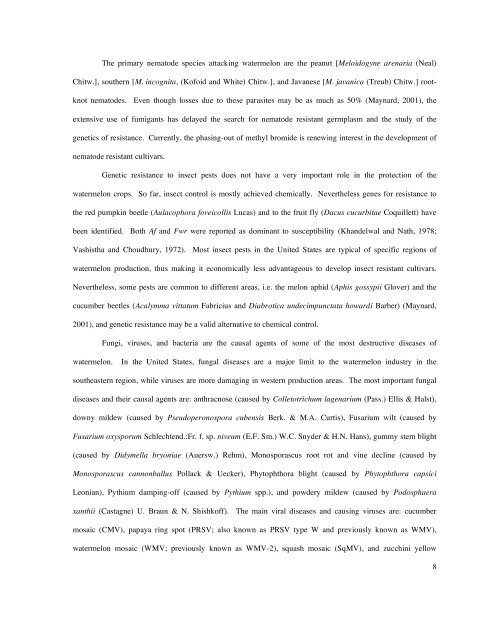Citrullus lanatus (Thunb.) Matsum. & Nakai - Cucurbit Breeding ...
Citrullus lanatus (Thunb.) Matsum. & Nakai - Cucurbit Breeding ...
Citrullus lanatus (Thunb.) Matsum. & Nakai - Cucurbit Breeding ...
You also want an ePaper? Increase the reach of your titles
YUMPU automatically turns print PDFs into web optimized ePapers that Google loves.
The primary nematode species attacking watermelon are the peanut [Meloidogyne arenaria (Neal)<br />
Chitw.], southern [M. incognita, (Kofoid and White) Chitw.], and Javanese [M. javanica (Treub) Chitw.] root-<br />
knot nematodes. Even though losses due to these parasites may be as much as 50% (Maynard, 2001), the<br />
extensive use of fumigants has delayed the search for nematode resistant germplasm and the study of the<br />
genetics of resistance. Currently, the phasing-out of methyl bromide is renewing interest in the development of<br />
nematode resistant cultivars.<br />
Genetic resistance to insect pests does not have a very important role in the protection of the<br />
watermelon crops. So far, insect control is mostly achieved chemically. Nevertheless genes for resistance to<br />
the red pumpkin beetle (Aulacophora foveicollis Lucas) and to the fruit fly (Dacus cucurbitae Coquillett) have<br />
been identified. Both Af and Fwr were reported as dominant to susceptibility (Khandelwal and Nath, 1978;<br />
Vashistha and Choudhury, 1972). Most insect pests in the United States are typical of specific regions of<br />
watermelon production, thus making it economically less advantageous to develop insect resistant cultivars.<br />
Nevertheless, some pests are common to different areas, i.e. the melon aphid (Aphis gossypii Glover) and the<br />
cucumber beetles (Acalymma vittatum Fabricius and Diabrotica undecimpunctata howardi Barber) (Maynard,<br />
2001), and genetic resistance may be a valid alternative to chemical control.<br />
Fungi, viruses, and bacteria are the causal agents of some of the most destructive diseases of<br />
watermelon. In the United States, fungal diseases are a major limit to the watermelon industry in the<br />
southeastern region, while viruses are more damaging in western production areas. The most important fungal<br />
diseases and their causal agents are: anthracnose (caused by Colletotrichum lagenarium (Pass.) Ellis & Halst),<br />
downy mildew (caused by Pseudoperonospora cubensis Berk. & M.A. Curtis), Fusarium wilt (caused by<br />
Fusarium oxysporum Schlechtend.:Fr. f. sp. niveum (E.F. Sm.) W.C. Snyder & H.N. Hans), gummy stem blight<br />
(caused by Didymella bryoniae (Auersw.) Rehm), Monosporascus root rot and vine decline (caused by<br />
Monosporascus cannonballus Pollack & Uecker), Phytophthora blight (caused by Phytophthora capsici<br />
Leonian), Pythium damping-off (caused by Pythium spp.), and powdery mildew (caused by Podosphaera<br />
xanthii (Castagne) U. Braun & N. Shishkoff). The main viral diseases and causing viruses are: cucumber<br />
mosaic (CMV), papaya ring spot (PRSV; also known as PRSV type W and previously known as WMV),<br />
watermelon mosaic (WMV; previously known as WMV-2), squash mosaic (SqMV), and zucchini yellow<br />
8
















